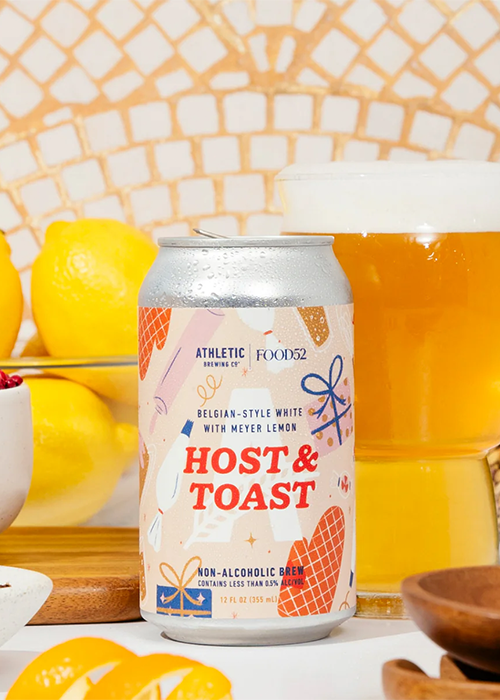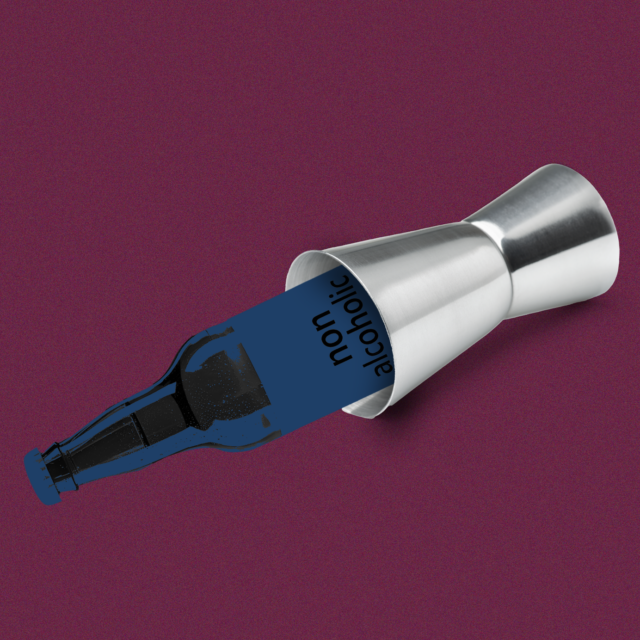By now, most beer fans are aware that they have way more — and, overall, wildly better — options for non-alcoholic (NA) lagers and ales, compared to just a few years ago. But for Josh Harris, founder of the celebrated San Francisco bar Trick Dog, today’s highly drinkable NA beers can also take another important field position: as an unexpected yet charismatic ingredient in creative, non-alcoholic cocktails.
“It’s like the possibilities are endless,” he says. “Non-alcoholic beers can add complexity, flavors, and individuality to people’s non-alcoholic programs.”
At Trick Dog, non-alcoholic beer has appeared in mixed drinks since the doors first opened in 2013. Back then, Harris says, there were very few quality NA beers available, and almost no noteworthy non-alcoholic versions of full-proof spirits and mixers. At most bars, non-alcoholic cocktails were generally an afterthought, if they existed at all, often only appearing as some type of limeade or lemonade.
“At that time, adding non-alcoholic beer to a drink honestly felt exciting and unexpected, and felt like it qualified the drink,” he says. “If we were looking for all of the different mechanisms that we could find to make a drink not be a ginger-mint limeade, adding non-alcoholic beer seemed like a really great one.”
Today, the growth and variety in the NA beer category pairs nicely with the growing interest in offering meaningful, noteworthy non-alcoholic cocktail programs.
“That’s why I think that this ingredient is being discovered as something that is, frankly, so obvious,” Harris says.
Complexity and Equivalency
Compared to the fresh fruit juices and herbs that are often used to make simple non-alcoholic drinks, NA beer offers several unique parameters, with various levels of fermentation complexity, yeast character, a wide variety of hop aromas, and bitterness. Some NA beers can offer acidity, in the case of a Gose or another sour style, as well as the mild sweetness of the maltose from barley malt, compared to far sweeter sucrose or fructose. Those characteristics are all important to consider, Harris says, though he adds that NA beer offers bartenders even more: It can help create a psychological equivalency between a non-alcoholic drink and the one that has booze.
“I think that one of the biggest things that we need to overcome is the idea that cocktails are for adults, and non-alcoholic drinks are like juice for kids,” he says. While the situation has improved in the past year or two, he adds, we’re still a long way from seeing NA cocktails get the same attention to detail as the full-proof recipes at most bars. “The biggest area for improvement in non-alcoholic drinks is bringing complex, mature flavors to the combinations,” he says.
Unlike in 2013, bartenders have an array of quality NA beers to use as potential ingredients today, from hazy IPAs to Mexican lagers and beyond.
“You can take the variety of those flavors and add them to drink styles,” Harris says. “You can make an Old Fashioned-style drink and make a stout foam and put that on top. You can do all of those things.”
“Using beer as an ingredient is wonderful, because it is so complex on its own that it really takes the breadth and the depth of a cocktail super far.”
As with that stout foam, non-alcoholic beer doesn’t have to be used in its traditional liquid state. Karl Góranowski, director of operations at Bad Jimmy’s in Phoenix, Ariz., and the founder of a forthcoming zine and popup series called Bar Nowhere, likes to use non-alcoholic beer in the form of a syrup, after starting out with regular beer syrups over a decade ago.
“With the sudden explosion of high-quality NA beers, a lightbulb went off,” he recalls. “I said, ‘I can utilize these flavors that I have been working with — porters and IPAs and these other highly flavorful things that I’ve been making syrups with — just without the alcohol.’”
For Derek Brown, bartender, podcaster, and author of “Mindful Mixology,” the relative weakness of most beer makes it fairly easy to emulate. By contrast, a non-alcoholic version of an 80-proof bourbon, for example, is clearly missing a much larger share of its overall flavor profile.
“That is a pretty good product, but really, it tastes more like a bourbon tea,” he says, speaking after a night at the Mindful Drinking Fest in Washington, D.C. By contrast, there’s not much difference between a great NA beer and the equivalent version with alcohol in terms of the flavors and textures it can add to a mixed drink. “It doesn’t feel as disjointed as some of the non-alcoholic spirits can feel,” Brown says.
New Approaches, New Techniques
As with any ingredient, how best to use NA beer in mixed drinks is open to interpretation and a variety of techniques. To make NA beer syrup, Góranowski recommends using a hotel pan or a similar vessel with the largest possible surface area and working with beers that are at room temperature, both of which help break the CO2 out of suspension. He does not heat his NA beer syrups, and prefers a 1.5 sugar-to-beer ratio. Patience is not optional.
“It normally takes two to three hours, but your results may vary,” he says.
The technique works well with stouts, porters, and other malt-focused beer styles. At his previous workplace, the award-winning Bata in Tucson, Góranowski used the NA version of AleSmith’s Speedway Stout to make a syrup with the exact same coffee, chocolate, and toffee notes as the original strong beer with 12 percent ABV. It adds some much-needed character to zero-proof versions of classic cocktails like the Old Fashioned, he says.
“One of the things that is missing from most of the NA spirit analogues is the depth and the richness that you’d get from the complex carbohydrate that is alcohol,” he says. “Using beer as an ingredient is wonderful, because it is so complex on its own that it really takes the breadth and the depth of a cocktail super far.”
For IPAs and other hop-forward styles, he highlights the importance of using products with recent packaging dates.
“Hop aromatics are the most volatile compounds in there. We want to make sure that we’re getting them at their peak flavor.”
In terms of combining flavors, a cautiously contrasting approach might work best. Amanda Hesser, founder of the culinary website Food52, recently helped develop a non-alcoholic wheat beer in partnership with Athletic Brewing. Called Host & Toast, the Belgian-style wheat beer was designed for holiday mixing.

“You have to be careful. You want a contrasting flavor, but you don’t want to drown out the flavor of the beer,” she says. “Otherwise, it just becomes carbonation. I would make sure to respect the flavor of the beer itself, and that you’re not crowding it out by adding a lot of other elements.”
Bubbles can be a key component — and then some. At Trick Dog, non-alcoholic Erdinger Weissbier, a German wheat beer, appears on the bar’s most recent menu in a drink called The Strong Man. Like many Trick Dog cocktails, it benefits from partial batching, as well as forced carbonation.
“We get this super-duper carbonated thing, which is a really fun trick for all carbonated drinks, including non-alcoholic beer,” Harris says. “It creates a super head, super foamy. The aesthetic is really great.”
When developing recipes, Brown recommends aiming for drinks of about four ounces, and praises the tactile qualities of NA beer as an ingredient. Bartenders can zero in on the hop bitterness of NA beer to replace the missing bite of alcohol in zero-proof cocktails, he says, or use it to add fullness and heft.
“It can elongate a drink without making it watery,” he says. “You’re actually increasing the viscosity, increasing the weight, so that could be really helpful.”
The New Is Old Again
While using NA beer in cocktails looks like a new trend, it does have its roots in the past. Beer has been part of cocktails for about as long as long as they have existed, Brown says, calling out the shandy as one of his all-time favorites, echoing the same praise Harris heaps on German radlers.
While zero-proof cocktails made with NA beer are only starting to hit the spotlight, the next big growth spurt might lie in the low-alcohol sector. Mixing a non-alcoholic American lager with standard-issue Aperol makes a fairly flavorful Spaghett, with less than a third of the alcohol of the standard drink. Micheladas, Boiler Rooms, and other beer mixers seem like they’re all ripe for the same treatment.
While Harris is glad to hear about more bars using NA beers in alcohol-free cocktails, he expresses surprise that the concept of offering interesting beverages for all customers isn’t more widespread.
“I’ve been sober for a really long time — over 20 years sober — so I’ve always felt like it was important to have a lot of options that didn’t have alcohol in them,” he says. “I think it’s only a matter of time before everybody gets there.”
